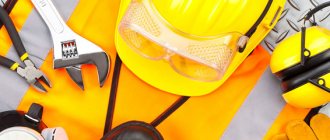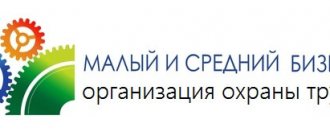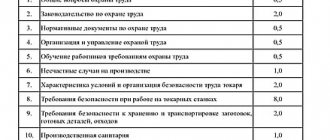What instructions should the company have?
Article 212 of the Labor Code of the Russian Federation states that the employee must be informed about all the risks, harmful and hazardous production factors at a particular workplace. The employee must know what protective measures he is required to use to eliminate health hazards.
Therefore, labor safety instructions must be developed at each workplace, depending on the tools, equipment, machines used by employees, as well as work conditions, for example, working at heights, working in electrical installations, working in confined spaces.
Each enterprise must have its own unique list of occupational safety instructions. Safety instructions are mandatory for all enterprises:
- when working on a PC and other office equipment.
- during operation, maintenance and repair of equipment
- during hot work
- when working at height
- when performing electric and gas welding work
As you can see, instructions are developed either by type of work or by profession. But there are also additional instructions, for example, when carrying out traveling work, when sending on a business trip, etc.
Enterprise documentation
To avoid disagreements affecting fire safety and labor protection measures, it is necessary to rely on regulatory documents. In different industries there are a large number of these documents that do not fit together. But there is a standard list of documentation that all enterprises, without exception, take as a basis. These are the documents:
- order of the head of the facility, which appoints someone responsible for fire safety;
- floor plans with evacuation routes marked, these plans are placed in prominent places on each floor of buildings;
- orders that legitimize activities related to conducting briefings, lectures, classes and exams to determine the quality of the information received;
- a log is kept in which all the above-described activities are displayed;
- acts in which the commission records the assessment of the acquired knowledge of employees and employees of the enterprise;
- when carrying out inspections of electrical networks, schedules for measuring the resistance of electrical networks, tables with standard indicators and other documents of this type will be required;
- logs in which all primary fire extinguishing agents are recorded, indicating the quantity, brands and service life;
- instructions and acts of the fire regime at the facility;
- acts that reflect the assessments of a special commission reflecting the fire safety of a production facility.
Fire safety briefing logbook
The rules and regulations of labor protection and fire safety are not as complicated as it might seem at first glance. For ordinary employees of the enterprise, they consist in the competent operation of technological and auxiliary equipment. Particular attention to the rules for carrying out work involving open fire or thermal methods for solving assigned problems. Not least important in fire safety is the restriction of smoking areas. That is, you can only smoke in strictly designated areas.
There are other requirements that are easy to fulfill. Eg:
- store oiled rags in special metal boxes;
- the same goes for workwear;
- keep the workplace clean;
- do not leave equipment, instruments or devices unattended that require constant human supervision.
This is all contained in the fire safety instructions, which every employee becomes familiar with during the training process. By the way, each briefing is recorded in a special journal, where those instructed are required to sign. And if the employee did not pass the occupational safety or fire safety exam, then he either did not attend classes, which means that the instructor who fictitiously conducted the classes is to blame. Or he was careless about the events being carried out. Which is also a minus for the instructor.
The video describes how to create a labor protection and fire safety system at your enterprise:
Who develops, coordinates and approves labor safety instructions
Before being allowed to work independently, workers must be familiarized with the labor safety instructions and tested for knowledge of safe techniques and work performance skills. This is the task of every immediate manager.
At the same time, monitoring the conduct of briefings and providing methodological assistance in developing instructions is the responsibility of a labor protection specialist .
The help of an occupational safety specialist consists of checking the correct application of regulatory legal acts, but safety measures for department heads and immediate supervisors need to be gleaned from the operating manual and labor protection rules.
Note! Article 212 of the Labor Code of the Russian Federation directly states that the employer coordinates draft rules and instructions on occupational safety with a representative body of employees, for example, a trade union.
Thus, approval of the instruction and its entry into force is impossible without the agreement of employee representatives. If such a body has not been created in the organization, it is necessary to create it if there is such an initiative. The initiative, we remind you, can come not only from the employees themselves, but also from conscious employers.
The role of the OT service is to provide methodological assistance, and then to monitor the correct application of the legislation and the training itself.
At many enterprises, instructions are drawn up by an occupational safety specialist, and then transferred to the department for signatures. This is incorrect and contradicts not only the Procedure for training and testing knowledge of labor protection requirements No. 1/29 of 01/13/2003, but also the regulations on the occupational safety and health system developed and approved at each enterprise (section - distribution of responsibilities of labor protection officials).
Alternatively, the safety specialist, together with the immediate supervisor in the department, develop instructions together, but only if the enterprise and the developer have no idea how to draw up this document.
After the department has prepared a draft instruction, a labor protection specialist reviews it, makes his comments or additions, and returns it to the developer for revision.
After this, once the instructions are corrected and the occupational safety specialist confirms this with his signature in the approval field, the instructions are submitted to the trade union committee for approval. Then, after the draft instructions are marked for approval, the project must be submitted for inclusion in the order for approval by the head of the organization.
Note! How to familiarize an employee with the occupational safety instructions must be indicated either in the training regulations, or in the regulations on the occupational safety management system, or in the order itself to put the instructions into effect.
As a rule, employees sign the introductory sheet for the instructions. It is recommended to create separate journals for issuing instructions on labor protection, but not prescribed in regulatory legal acts.
Tasks of labor protection and fire safety
The goals of labor protection and fire safety at enterprises are to preserve the health and life of employees. A number of measures are used to achieve this. Which ones:
- organizing work in such a way that fire safety requirements are fully met;
- conditions are created under which workers at the production facility fully understand the requirements for fire safety and labor protection;
- encourage employees and workers who increase their competence in these rules;
- the rules approved by the industrial safety and health regulations must be strictly followed;
- deviations in the technological process should not be allowed, regardless of the type of activities being carried out, because any, even the most insignificant, mistake can lead to tragedy, this also applies to injury and the appearance of fires;
- strictly comply with fire safety regulations;
- The responsibilities of the management of the enterprise and ordinary workers are necessarily divided.
The tasks and goals described above are not difficult. They must be complied with by all workers and employees of the production facility without question.
Work injury
On the basis of what documents are instructions developed?
Safety instructions are developed on the basis of labor protection rules, operating instructions, taking into account the job responsibilities of a particular employee . If an employee performs part-time work, then he needs to be familiarized with the instructions both at the main and at the combined workplace.
But if both electric forklifts and forklifts are used in the same workshop, it is necessary to develop instructions for each type of fuel, even though the worker has the same profession - forklift driver. Therefore, instructions are developed in strict accordance with the type of equipment or machines being serviced. In one case, the fuel system is gasoline, and in the other, it is powered by electric energy. Accordingly, security measures will differ.
Frequency of revision of instructions and their validity period
The instructions require revision if:
- there was a change in the technological process
- replacement of production equipment was required
- personal or collective protective equipment has changed
- the materials and (or) raw materials used in production have changed, as a result of which the level of factors specified in the instructions that affect workers has changed
When introducing new jobs, instructions should be developed no later than the new employee starts work. Therefore, if the technological process has not been carried out at the workplace before, before the work begins, employees must be trained on the new instructions.
The validity period of occupational safety instructions is not established by law. The employer has the right to do this independently. At the same time, for electrical technical personnel, the period for reviewing instructions is once every 5 years.
Completion of initial fire safety training (FS)
The legal side of this procedure is determined by Art. 25 Federal Law No. 69 of December 21, 1994 and Fire Safety Standards (Order of the Ministry of Emergency Situations No. 645 of the Russian Federation of December 12, 2007). This type of training must be carried out by the employer or the responsible person appointed by him.
This procedure is provided for the purpose of prevention and elimination of fires and fire hazardous situations. The task is to familiarize those starting work with the basic principles of fire safety and the correct behavior in case of fires and fires.
The designated authorized employee undergoes appropriate training and receives a certificate. Only after this he has the right to begin performing his function in terms of instructing.
| Circle of instructed persons | Features of the procedure | Generation of related documentation |
| All new employees without exception; seconded from third-party organizations; trainees or students; builders (installers); employees who have started new work; other persons by order of the employer | Instruction is provided upon hiring Instruction point: organizational unit (place of work) Instruction format: individual or group (i.e., several employees of the same department are instructed, where the same equipment is available) Theory must be reinforced by practice (employees must demonstrate the acquired knowledge in practice, for example, show how to use fire extinguishing agents) | The person responsible for the instruction must: develop and agree on a training program taking into account current standards and specialization; keep a log book, mark in it the conduct of briefings with affixing your own visa and signatures of those being instructed |
Based on the results of the training, employees should:
- Know the key requirements of industrial safety regulations.
- Understand for yourself possible dangerous situations that may arise within the framework of ongoing technological processes.
- Learn to use primary fire protection equipment.
- Be able to act correctly in case of fire (evacuation, assistance).
All employees who have undergone workplace safety training are required to know and put into practice the listed minimum.










